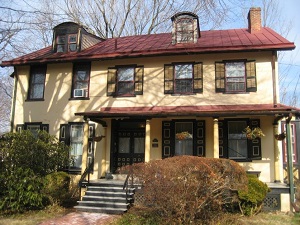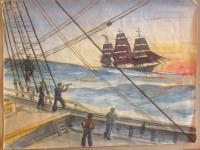This past winter and spring HCI-PSAR facilitated an internship program that paired emerging archivists in need of hands-on experience with small repositories in need of processing assistance and large repositories willing to train and supervise the intern. We matched intern Diane Biunno with Radnor Historical Society and Independence Seaport Museum. Diane reflected on the Edward Brownlee collection, the Musical Coterie of Wayne records, and her other experiences in the blog below.
Pirates and Prima Donnas: An Intern's Adventure in the Archives
By Diane Biunno
This past winter I served as an intern for the Historical Society of Pennsylvania's Hidden Collections Initiative for Pennsylvania Small Archival Repositories (HCI-PSAR) project. The internship provided me with training I'll need in my future career and gave me insight into the needs and inner workings of both large and small repositories.
During the first stage of my internship, I processed the Edward Brownlee collection at the Independence Seaport Museum under the supervision and guidance of the Director of Archives, Sarah Newhouse. I encourage anyone interested in Philadelphia maritime history to visit both the museum and the archive and to take a tour of the Olympia, the world's oldest floating steel warship.

Edward Brownlee aboard the Schooner Copperfield which encountered a hurricane off of New York. 1932
Edward Brownlee was a naval architect and historian whose papers included original artwork, ship plans and blueprints, photographs, newspaper clippings, and research materials and personal papers. Despite his initial tragic experiences at sea, Brownlee fell in love with ship building. As a young man on his first voyage on the Schooner Nomis in 1932, his ship became swamped in a gale off Cape Hatteras, North Carolina and had to be rescued by the Coast Guard. A few months later he set sail on the Schooner Copperfield and was shipwrecked again when the Copperfield encountered a hurricane. The collection includes logbooks and journals from these ill-fated voyages, as well as letters to his understandably concerned mother.

Schooner Copperfield. Original watercolor by Edward Brownlee.
Brownlee's collection is unlike most of the other collections that I've processed because the materials were already well organized and clearly labeled. Consequently, this collection was well suited to the more product less process (MPLP) approach. However, I still needed to adapt my MPLP skills because the collection materials were organized at an extremely granular level. My supervisor and I agreed that it would best serve the collection and future researchers to keep the level of granularity and to describe the collection of approximately 50 original ship plans at the item level.

Original watercolor by Edward Brownlee.
During the second stage of my internship, I had the opportunity to process the Musical Coterie of Wayne Collection at the Radnor Historical Society in Wayne, Pennsylvania. I encourage anyone interested in the history of the Main Line to visit the Finley House, the headquarters of the Radnor Historical Society, and to view their unique collections and museum pieces.

Finley House. Headquarters of Radnor Historical Society.
The Musical Coterie of Wayne was established in 1911, is still active as of 2014, and began as a women's choral group that performed in the homes of its members. The collection includes their administrative, financial, and membership records, as well as a number of scrapbooks, photographs, and printed materials.

Musical Coterie of Wayne. Unprocessed.

Musical Coterie of Wayne. Processed.
In addition to receiving training and gaining archival processing experience, I also participated in two HCI-PSAR workshops aimed at addressing the needs of small repositories. The first workshop focused on archival processing, while the second gave helpful advice on how to digitize collections.
I'd like to thank everyone involved in granting me the opportunity to participate in the HCI-PSAR internship. I'm grateful for all the wonderful archivists I've met during this experience who all offered me professional advice and support. In particular, I'd like to thank HCI-PSAR staff at the Historical Society of Pennsylvania, as well as staff at the Independence Seaport Museum and the Radnor Historical Society.

